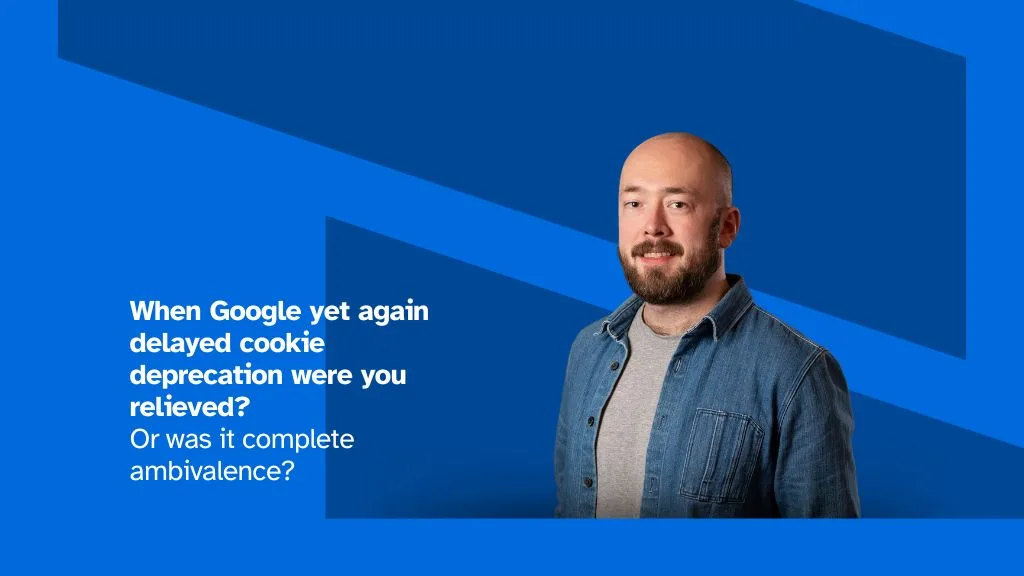By Jonny Whitehead, Strategy Director, Skyrise
When Google yet again delayed cookie deprecation last month, were you relieved? Or did you meet the news with complete ambivalence?
The answer to this question will reveal which side of the philosophical divide facing digital advertising you are on.
On one side there are the practitioners who rely on individual identifiers to track campaign metrics and report back numbers of leads, sales and other performance indicators to be directly attributed to their ad spend.
On the other, there are those who recognise that cookies are already dead and that digital attribution has always been utterly misleading. These people are unaffected by Google’s announcement as they are already embracing the opportunity to free themselves from its shackles.
Attribution has lost its allure
It’s easy to see why the industry has become so hooked on the metrics that are easiest to count.
In the mid 2000s, as a young, fresh faced media planner (with a full head of hair), I was one of the new breed of digital media planners who proudly presented reams of numbers in presentations to my clients. Much to the dismay of my counterparts in ‘old’ media channels, who came to client meetings armed with press cuttings and pictures of buses.
Suddenly our client’s prayers had been answered. They were able to solve John Wanamaker’s age-old problem and figure out which half of their advertising spend was being wasted.
Unfortunately what we didn’t know was that the numbers were grossly inflated or being gamed by bad actors. Over time the initial shine of the data wore off as we realised the levels of duplication and manipulation.
First there was the revelation of ‘retargeting’ that was being carried out behind the scenes. Then viewability tracking suggested that ads which had not been seen by humans were resulting in leads and sales. Throughout there was a growing uneasiness about attributing so much responsibility to tiny ads served on mobile screens when a national OOH campaign was also live at the same time.
Embrace effectiveness
From the work done by the IPA and various other people, we know that reach is one of the primary tenets of effective media campaigns.
By optimising to digital attribution, digital media buyers are restricting themselves to the environments in which that technology is present. This has a damaging effect on their audience reach and therefore their campaign effectiveness – before they even start.
If you know that your audience is most likely to use iPhones, then why target mobile web ads on android devices just because you can generate numbers to count?
Chasing misleading numbers rather than being guided by effectiveness has an impact at the channel-planning level too. For years channels have been falsely bucketed into silos based on whether they generate attributed metrics.
Digital display ads are considered to be drivers of direct response and channels without digital attribution are considered to be drivers of brand metrics, simply because display ads are linked to adservers and identifiers.
Guess what? Both channels do both things to varying degrees, depending on how you use them. Philosophically abandoning digital attribution means you are free to get the best out of all channels relative to your objective.
Human vs machine (or, human + machine)
Blind algorithms based on digital attribution offer a seemingly perfect solution to time poor media planners with an increasingly complex ad ecosystem to contend with. However knowingly or unknowingly, they are biased and require human oversight.
If we create an algorithm that is pointed at a certain metric, other factors will inevitably be deprioritised in preference of that metric. If an algorithm is created by a media owner or technology company with vested interests, it will work toward those vested interests.
Proper media planning, routed in classical planning but powered by technology, is needed to ensure these biases don’t take over. Blind algorithms do not allow media planners the visibility or control required to do so.
The key to success is in balancing evidence-based strategic planning with the ability to give algorithms space to perform without having free reign.
The joy of… patience and realistic budgets
One of the most appealing aspects of digital attribution is in the immediacy of its feedback.
As Les Binet eloquently put it; “Attribution – quickly and cheaply – will give you an answer that is precise and wrong”.
Econometrics and A/B testing undoubtedly take longer to provide usable outtakes but the benefits of patience are many. As well as the reassurance that you are not being led astray by misleading data, is the opportunity to understand how different channels work alongside and compliment one another.
If you are in the process of philosophically facing up to the fact that those ‘30 day, £10k tests’ may not have been giving you the answers you thought they were, you are probably also coming to the realisation that larger budgets are needed to produce meaningful results.
Media response curves are S shaped. You need to spend enough to get past the first bend while stopping short of the second one. This doesn’t mean that it’s impossible to carry out a reliable test without breaking the bank. It simply means setting realistic parameters and expectations to provide the best chance of success.
The future is better
If I still need to convince you of the benefits of joining me on my side of the philosophical fence, consider the ethical benefits alongside those related to campaign effectiveness and practicalities.
Not only does disregarding attribution mean limiting invasive user tracking, it also allows us to reduce the amount of data transactions that contribute to our industry’s collective carbon footprint.
When GDPR was announced and the cookie began to crumble, like most I was concerned about the future of digital marketing. Now, I believe it to be the best thing to happen to our industry in 20 years.









